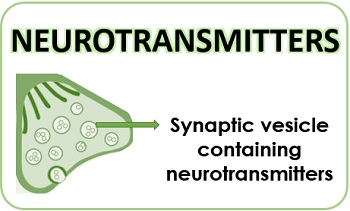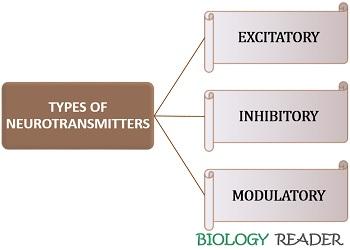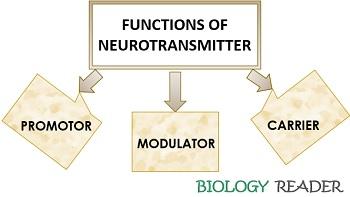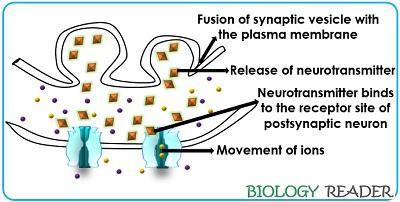Neurotransmitters refer to the chemical messenger molecules, which contain amino acids, amines, purines and neuropeptides. Its activity may trigger or restrict nerve impulse production. Its synthesis occurs endogenously by the presynaptic neuron.
Neurotransmitters release out upon membrane stimulation. They ensure neurotransmission by transmitting an action potential beyond the chemical synapse.
Our nervous system uses neurotransmitters as the carrier molecules, which trigger the opening of voltage-gated channels after binding with the neuron’s specific receptors. By doing so, they allow the movement of ions beyond the membrane, which eventually stimulate the action potential to move althrough the axon.
In this post, we will study the definition, location, function and three common types of neurotransmitters (excitatory, inhibitory and modulatory). In addition, some ideal properties, important facts and features have also been explained.
Content: Neurotransmitters
Definition of Neurotransmitter
It refers to the endogenous chemical agents whose synthesis occurs within the neurons by the association of ER and Golgi body. ER provides the active precursors for the synthesis of neurotransmitters, and Golgi bodies help in packaging neurotransmitters into the vesicles. Synaptic vesicles encircle neurotransmitters.

The neurotransmitter comes into action once the synaptic vesicles rupture after coming in contact with the plasma membrane. The fusion causes the release of chemical messengers, which can either excite or inhibit the nerve signal transmission towards the adjoining neuron. The chemical messengers bind with the corresponding receptors of the postsynaptic neuron.
Location
Neurotransmitters are packaged within the small spherical bundles known as synaptic vesicles. They are found towards the periphery of the axon’s endings. In chemical synapses, the synaptic vesicles are small and round, whereas the vesicles exhibit pleomorphic shape in electrical synapses.
Types of Neurotransmitters
Based on the functional role inside a nerve cell, a neurotransmitter is typically grouped into the following classes:

Excitatory Neurotransmitters
From the name, it’s quite clear that this kind of chemical messenger will excite or promote an action potential to move beyond the presynaptic neuron. In simple words, the excitatory neurotransmitter can persuade the target cell or neuron into action.
Besides, they can also modulate the transmembrane ion flow through different channels and facilitate nerve signal generation and propagation.
A chemical messenger (like acetylcholine) acts as an excitatory neurotransmitter that activates cation channels (like Na+ and Ca2+) and causes depolarization. They also include chemical messengers like histamine, glutamate, epinephrine, norepinephrine, acetylcholine, and dopamine.
Inhibitory Neurotransmitters
They are the chemical messengers that hinder the firing of an action potential across the presynaptic membrane. Merely, an inhibitory neurotransmitter can dissuade the target cell or neuron into action. They do not facilitate the generation and propagation of a nerve impulse.
A chemical messenger (for example, GABA) acts as an inhibitory neurotransmitter, activating anion channels (like Cl–) and cause hyperpolarization. They also include chemical messengers like GABA, taurine, acetylcholine, dopamine.
Modulatory Neurotransmitters
They function as neuromodulators, which regulate the functioning of other neurons. Some of the neuromodulators include dopamine, histamine, and acetylcholine.
Modulatory neurotransmitters do not participate in neurotransmission, which means they are neither reabsorbed by the presynaptic neuron nor break down into metabolites. Modulatory neurotransmitter influences the overall activity level of the brain.
Neurotransmitter Functions
Neurotransmitter performs the following tasks in a nervous system.

- Carrier agent: Neurotransmitter acts like a carrier molecule, which is released beyond the axolemma along with the nerve signal. Its role is not over yet, as it also propagates the nerve signal to the adjoining or postsynaptic neuron after specific binding with the receptors site.
- Booster: Neurotransmitter boosts nerve signal conduction from neuron to neuron or neuron to the target cell.
- Modulatory factor: Besides accelerating and inhibiting the conduction of action potential, a neurotransmitter also functions to balance the signal between the neurons.
Features and Facts
Neurotransmitters share the following characteristics and facts that are mentioned below:
- Neurotransmitters contribute to chemical neurotransmission.
- It plays a fundamental role in physical (muscle movement, heart rate, etc.) and psychological functions (mood, fear, etc.) in our body.
- Neurotransmitter was first described by a scientist named Otto Loewi in the year 1926. He conducted experiments on the vagus nerves of frogs, after which he confirmed that the neurons could communicate by releasing some chemicals.
- Excitatory, inhibitory and modulatory neurotransmitters are the three different modes of action performed by the neurotransmitter.
- There are approximately 1000-10000 neurotransmitters per synaptic vesicle.
- Its continuous production withholds our brain in function.
- An increase or decrease in the level of neurotransmitter production influences our body’s physical and psychological activities.
- The deficiency of neurotransmitters is linked with certain neurodegenerative diseases. For example, lack of ACH (Acetylcholine) and glutamate causes neurodegenerative Alzheimer’s disease.
- An activity of a neurotransmitter may get affected by the ingestion of certain drugs like dopamine and even by the action of other neurotransmitters.
- The neurotransmitters are produced by the amino acid precursors and enzyme system inside the neuron.
Ideal Properties of Neurotransmitter
To recognize the neurotransmitter, the following points you should keep in mind.
- The endoplasmic reticulum must contribute to the production of active precursors and enzymes necessary for synthesising neurotransmitters.
- A Golgi body of neuron must package the neurotransmitters around a protein covering (in the form of small vesicles) to protect them against degeneration.
- There must be an adequate number of neurotransmitters whose binding with the postsynaptic receptors could stimulate a response.
- For neurotransmission, the chemical messengers should diffuse beyond the presynaptic neuron. The postsynaptic neuron should comprise cell receptors to which a chemical messenger could selectively bind.
- There should be reuptake systems so that free neurotransmitters in the synaptic cleft junction could move back into the presynaptic neuron to prevent the loss of neurotransmitters.
What do Neurotransmitters do?
The synaptic vesicle possesses thousand of neurotransmitters towards the bulbous endings. The axon’s terminal region serves as the active zone of a neuron. The moving down of action potential results in a fusion of synaptic vesicles with the axon’s plasma membrane.
As a result of integration, the chemicals messengers disperse beyond the membrane and bind with the receptor sites of the postsynaptic neuron. The receptor proteins bring out certain modifications in the chemical messenger by activating ion channels.

The cell receptors also mediate the transformation of chemical information into electrical form. After regulating ion channels, the binding of neurotransmitter and receptor exhilarates ion fluxes beyond the membrane.
Depending upon the type of channels and ions fluxed into the membrane cause depolarization or hyperpolarization. A depolarized state in which an inner membrane possesses positive charges.

A hyperpolarized state is an inner layer, which possesses negative charges due to the influx of chloride ions via chloride gated channels. If a cell reaches a threshold of depolarization, it will trigger the influx of more electropositive sodium ions into the electronegative cytosol via sodium voltage-gated channels.
Then, depolarization of the membrane stimulates the propagation of an action potential. When an action potential reaches the region of bulbous swelling, the arrival of positive charges triggers the opening of calcium gated channels.
Afterwards, the channels allow the movement of calcium ions into the membrane. The integration of axolemma and vesicles cause the dispersal of chemical messengers into the synaptic cleft, and the process repeats similarly.